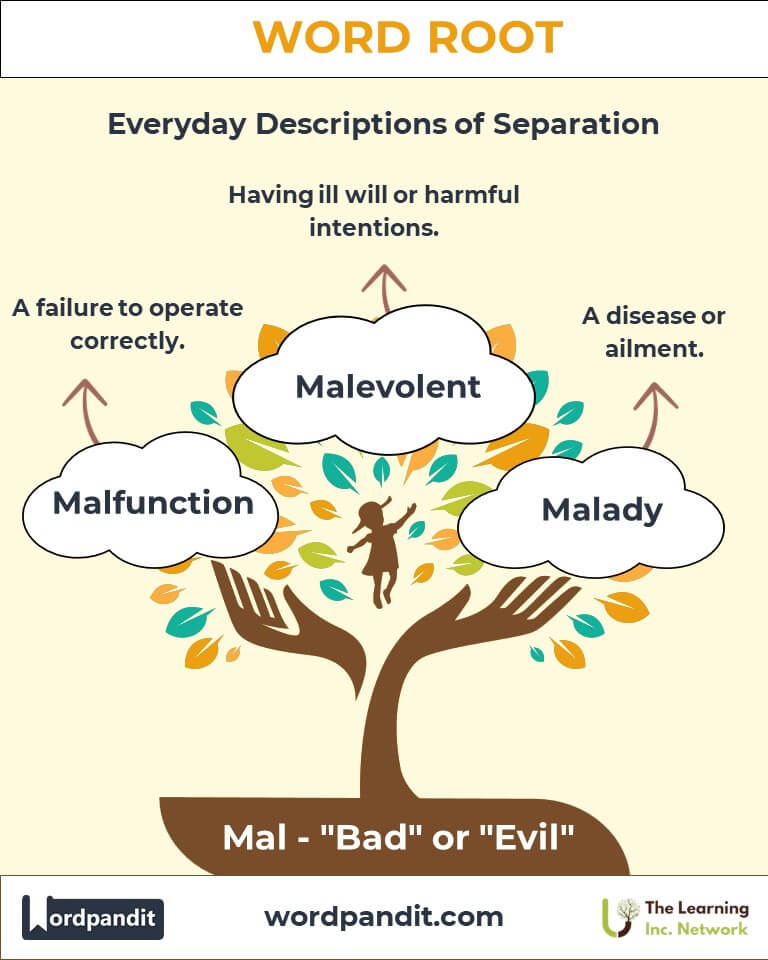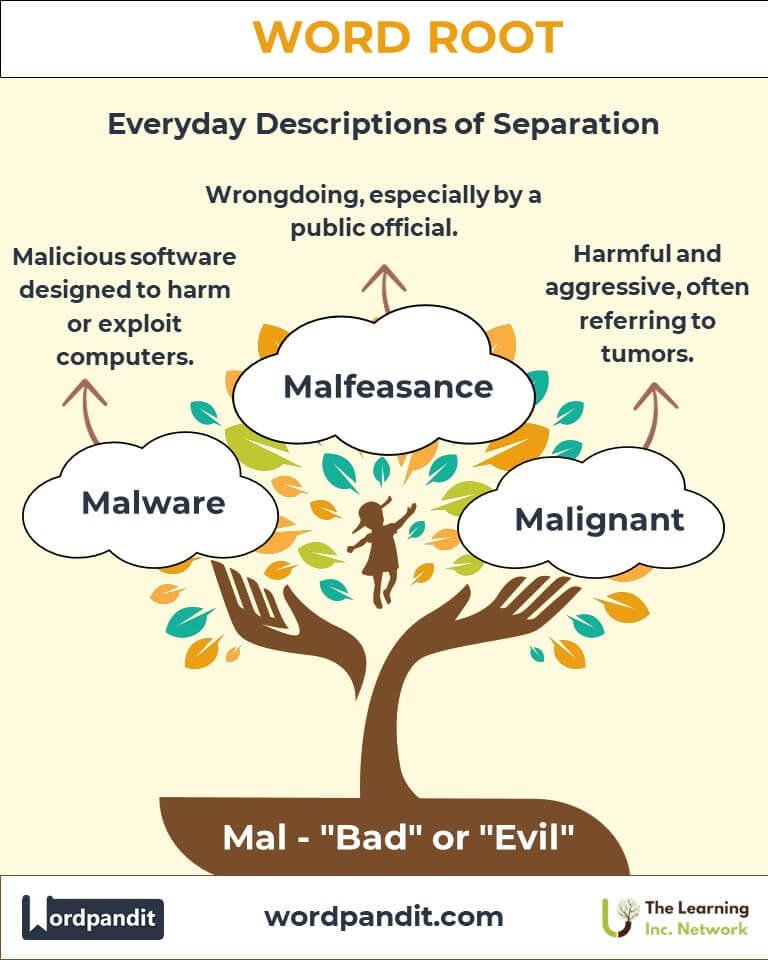Mal: The Root of Badness in Language and Contexts
Discover the depths of the root "Mal," derived from Latin, signifying "bad" or "evil." From terms like "malfunction" to "malevolent," this root captures negativity in a wide array of contexts, spanning from common usage to specialized disciplines. Understanding "Mal" enriches your vocabulary and unveils the influence of this root across language, history, and culture.
Table of Contents
- Introduction: The Essence of "Mal"
- Etymology and Historical Journey
- Mnemonic: Unlocking the Power of Mal
- Common "Mal"-Related Terms
- "Mal" Through Time
- "Mal" in Specialized Fields
- Illustrative Story: "Mal" in Action
- Cultural Significance of the "Mal" Root
- The "Mal" Family Tree
- FAQs About the agr Word Root
- Test Your Knowledge: agr Word Root Quiz
- Conclusion: The Legacy of "Mal"
Introduction: The Essence of "Mal"
From malevolent intentions to malfunctioning gadgets, the root "Mal" expresses something wrong, harmful, or negative. Derived from the Latin word malus (meaning "bad" or "evil"), this root forms the basis of many words used to describe unfavorable situations or characteristics. Whether you're describing a technical issue, an illness, or an ill will, "Mal" conveys a universal sense of adversity.
Etymology and Historical Journey
The root "Mal" originates from Latin, where malus meant "bad" or "evil." Over centuries, it entered English via Old French, often appearing as a prefix in terms denoting negativity. During the Middle Ages, words like "malady" (illness) and "malfeasance" (wrongdoing) emerged, blending Latin roots with French linguistic influences. As language evolved, "Mal" became synonymous with misfortune or malfunction, finding a home in technical, legal, and everyday contexts.
Mnemonic: Unlocking the Power of Mal
To remember "Mal," visualize a mischievous character causing chaos wherever they go. Imagine their name is Mal, representing all things harmful or undesirable.
Mnemonic Device: "Mal means trouble—malfunctions, malice, and maladies abound!"
Common "Mal"-Related Terms
- Malfunction (mal-funk-shun): A failure to operate correctly.
Example: "The printer's malfunction delayed the project."
- Malevolent (ma-leh-voh-lent): Having ill will or harmful intentions.
Example: "The malevolent character plotted against the hero."
- Malady (ma-luh-dee): A disease or ailment.
Example: "Doctors worked tirelessly to cure the malady."
- Malfeasance (mal-fee-zuhns): Wrongdoing, especially by a public official.
Example: "The politician was impeached for malfeasance."
- Malodorous (mal-oh-duh-ruhs): Having an unpleasant smell.
Example: "The malodorous garbage needed immediate disposal."
"Mal" Through Time
- Malaria:
Originally thought to be caused by "bad air" (Latin: "mala aria"), this term evolved to describe a mosquito-borne disease.
- Malefactor:
Historically used to describe a criminal or wrongdoer, reflecting its roots in "male" (bad) and "facere" (to do).
"Mal" in Specialized Fields
- Medicine:
Malignant: Referring to harmful and aggressive conditions, such as malignant tumors.
Example: "Early detection of malignant cells can save lives."
- Technology:
Malware: Software designed to harm or exploit computers.
Example: "Installing antivirus software protects against malware."
- Law:
Malfeasance: Official misconduct or wrongful actions.
Example: "The court investigated the allegations of malfeasance."
Illustrative Story: "Mal" in Action
Liam's day started with a malfunctioning alarm clock, causing him to arrive late to work. As he entered, he overheard his colleagues discussing a malevolent hacker who had unleashed malware on the company’s systems. Despite the malady of bad luck surrounding the day, Liam's quick thinking helped neutralize the threat. The root "Mal" defined his challenging yet triumphant experience.
Cultural Significance of the "Mal" Root
The "Mal" root frequently appears in storytelling and culture. From Disney's Maleficent, symbolizing ill will and power, to the literary depiction of "maladies" as metaphors for societal flaws, "Mal" resonates as a marker of adversity and intrigue. It underscores humanity’s struggles and triumphs against misfortune.
The "Mal" Family Tree
- Bene (good):
Example: Benevolent (well-meaning).
- Mis (wrong):
Example: Misfortune (bad luck).
- Dys (abnormal):
Example: Dysfunctional (not operating properly).

FAQs About the "Mal" Word Root
Q: What does "Mal" mean, and where does it come from?
A: The root "Mal" means "bad" or "evil," derived from the Latin word malus. It conveys a sense of negativity, harm, or dysfunction. Over time, "Mal" entered English primarily through Old French, forming words that describe misfortune, wrongdoing, or undesirable conditions.
Q: Is "Mal" always negative?
A: Yes, the "Mal" root consistently carries a negative connotation. Whether it’s describing bad actions (malfeasance), harmful conditions (malady), or technical failures (malfunction), this root encapsulates the idea of something undesirable or harmful.
Q: What is the difference between "malfunction" and "malfeasance"?
A:
- Malfunction: Refers to a technical or operational failure, such as a machine or system not working as intended. Example: "The car's malfunction left them stranded."
- Malfeasance: Refers to intentional wrongdoing or misconduct, typically by someone in authority, such as a public official. Example: "The mayor was accused of malfeasance for misusing funds."
Q: What does "Malevolent" mean, and how is it different from "Malicious"?
A:
- Malevolent: Means having ill will or harmful intentions. It’s often used to describe a person’s disposition or attitude. Example: "The malevolent character plotted revenge."
- Malicious: Refers to actions driven by malice or spite. It emphasizes harmful intent in behavior. Example: "The malicious prank caused unnecessary harm."
Q: What is malware, and how is it different from a malfunction?
A:
- Malware: Refers to malicious software designed to harm, exploit, or steal data from a system. Examples include viruses, spyware, and ransomware.
- Malfunction: Refers to a failure in a system or device due to technical or operational issues, not necessarily caused by an external malicious actor.
Q: Why is "Malaria" associated with the "Mal" root?
A: The name "Malaria" stems from the Italian words mala aria, meaning "bad air." Historically, it was believed that the disease was caused by foul air in swampy regions. Although now known to be mosquito-borne, the term has persisted as a reminder of earlier medical beliefs.
Q: How does "Malignant" relate to the "Mal" root?
A: "Malignant" is derived from the Latin malignus (evil or harmful) and is used in medical contexts to describe life-threatening conditions, such as cancerous tumors. It contrasts with "benign," which describes non-harmful conditions. Example: "The malignant tumor required immediate treatment."
Test Your Knowledge: Mal Word Root Quiz
1. What does the root "Mal" signify?
2. Which term refers to harmful software?
3. What does "Malevolent" mean?
4. What is the meaning of "Malfunction"?
5. How did "Malaria" get its name?
Conclusion: The Legacy of "Mal"
The root "Mal" underscores the universal presence of adversity in life and language. Its influence spans disciplines, reflecting the multifaceted nature of harm and misfortune. By understanding "Mal," we gain insight into the richness of language and the human experience, navigating challenges with knowledge and resilience.













